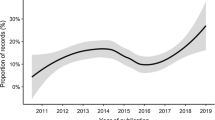Abstract
The six-food elimination diet (SFED), where dairy, wheat, eggs, soy, nuts, and seafood are avoided, is an effective treatment for eosinophilic esophagitis (EoE). Patient-related costs of this approach, however, are unknown. We aimed to assess the cost of and ease of shopping for an SFED compared to an unrestricted diet. A dietitian with expertise in EoE generated menus meeting dietary requirements for a week’s worth of meals for the SFED and an unrestricted diet. We compared prices and the number of missing items for both diets at standard and specialty grocery stores. The average weekly price of the SFED at a standard supermarket was $92.54 compared to $79.84 for an unrestricted diet (p = 0.0001). A patient shopping at a standard grocery store needed a higher proportion of items from a second store compared to an unrestricted diet (32 vs. 3 %, p = 0.0001). The prices of the SFED and unrestricted diet using a specialty supermarket were comparable ($106.47 vs. $105.96, p = 0.81), as was the percentage of items requiring a trip to a second store (6 vs. 2 % items, p = 0.03). Shopping at a specialty grocery store increased weekly grocery costs by $13.93 (p = 0.04) for the SFED and $26.12 (p = 0.03) for the unrestricted diet. In conclusion, for patients shopping at standard grocery stores, the cost of an SFED is higher, and an SFED requires more items from a second store. These differences disappear at specialty grocery stores, but costs were significantly higher. This cost and logistical burden can inform patients when selecting dietary therapy.

Similar content being viewed by others
References
Liacouras CA, Furuta GT, Hirano I, et al. Eosinophilic esophagitis: updated consensus recommendations for children and adults. J Allergy Clin Immunol. 2011;128(3–20):e6.
Dellon ES, Gonsalves N, Hirano I, et al. ACG clinical guideline: evidence based approach to the diagnosis and management of esophageal eosinophilia and eosinophilic esophagitis. Am J Gastroenterol. 2013;108:679–92.
Dellon ES, Liacouras CA. Advances in clinical management of eosinophilic esophagitis. Gastroenterology. 2014;147:1238–54.
Dellon ES, Jensen ET, Martin CF, Shaheen NJ, Kappelman MD. Prevalence of eosinophilic esophagitis in the United States. Clin Gastroenterol Hepatol. 2014;12(589–596):e1.
Rothenberg ME. Molecular, genetic, and cellular bases for treating eosinophilic esophagitis. Gastroenterology. 2015;148:1143–57.
Markowitz JE, Spergel JM, Ruchelli E, Liacouras CA. Elemental diet is an effective treatment for eosinophilic esophagitis in children and adolescents. Am J Gastroenterol. 2003;98:777–82.
Peterson KA, Byrne KR, Vinson LA, et al. Elemental diet induces histologic response in adult eosinophilic esophagitis. Am J Gastroenterol. 2013;108:759–66.
Kagalwalla AF, Sentongo TA, Ritz S, et al. Effect of six-food elimination diet on clinical and histologic outcomes in eosinophilic esophagitis. Clin Gastroenterol Hepatol. 2006;4:1097–102.
Gonsalves N, Yang GY, Doerfler B, et al. Elimination diet effectively treats eosinophilic esophagitis in adults; food reintroduction identifies causative factors. Gastroenterology. 2012;142(1451–9):e1.
Wolf WA, Jerath MR, Sperry SL, Shaheen NJ, Dellon ES. Dietary elimination therapy is an effective option for adults with eosinophilic esophagitis. Clin Gastroenterol Hepatol. 2014;12:1272–9.
Arias A, Gonzalez-Cervera J, Tenias JM, Lucendo AJ. Efficacy of dietary interventions for inducing histologic remission in patients with eosinophilic esophagitis: a systematic review and meta-analysis. Gastroenterology. 2014;146:1639–48.
Kelly KJ, Lazenby AJ, Rowe PC, et al. Eosinophilic esophagitis attributed to gastroesophageal reflux: improvement with an amino acid-based formula. Gastroenterology. 1995;109:1503–12.
Spergel JM, Brown-Whitehorn TF, Beausoleil JL, et al. 14 years of eosinophilic esophagitis: clinical features and prognosis. J Pediatr Gastroenterol Nutr. 2009;48:30–6.
Lucendo AJ, Arias A, Gonzalez-Cervera J, et al. Empiric 6-food elimination diet induced and maintained prolonged remission in patients with adult eosinophilic esophagitis: a prospective study on the food cause of the disease. J Allergy Clin Immunol. 2013;131:797–804.
Cotton CC, Hiller S, Green DJ, et al. Six-food elimination diet or topical steroids for first-line treatment of eosinophilic esophagitis? A cost-utility analysis. Gastroenterology. 2015;148(Suppl 1):S-2.
Burwell S. Annual update of the HHS poverty guidelines. Fed Reg. 2015;80:3236–7.
Doerfler B, Bryce P, Hirano I, Gonsalves N. Practical approach to implementing dietary therapy in adults with eosinophilic esophagitis: the Chicago experience. Dis Esophagus. 2015;28:42–58.
USDA. Official USDA food plans: cost of food at home at four levels, US average, December 2015. 2016.
Author Contributions
WAW: Data analysis, drafting of the manuscript, critical revision of the manuscript, KZH: Data acquisition, drafting of the manuscript, critical revision of the manuscript, RD: Technical expertise, critical revision of the manuscript, ZJI, BSR, and FJK: Data acquisition, critical revision of the manuscript, ESD: Study concept and design, study oversight, critical revision of the manuscript.
Funding and Grant Support
This research was funded in part by T32 DK07634 (WAW), T35 DK007386 (KZH), K23 DK090073 (ESD), and R01 DK101856 (ESD).
Author information
Authors and Affiliations
Corresponding author
Ethics declarations
Disclosures
Dr. Wolf has received support from Nestlé Corporation to attend educational events. Dr. Dellon has received research funding from Meritage, Miraca Life Sciences, Receptos, and Regeneron, and has been a consultant for Aptalis, Novartis, Receptos, Regeneron, and Roche. None of the other authors have any relevant disclosures, and there are no potential conflicts related to this manuscript.
Electronic supplementary material
Below is the link to the electronic supplementary material.
Rights and permissions
About this article
Cite this article
Asher Wolf, W., Huang, K.Z., Durban, R. et al. The Six-Food Elimination Diet for Eosinophilic Esophagitis Increases Grocery Shopping Cost and Complexity. Dysphagia 31, 765–770 (2016). https://doi.org/10.1007/s00455-016-9739-1
Received:
Accepted:
Published:
Issue Date:
DOI: https://doi.org/10.1007/s00455-016-9739-1




